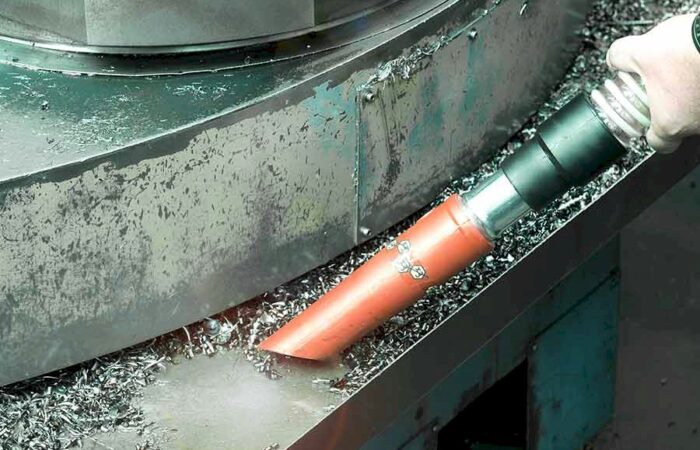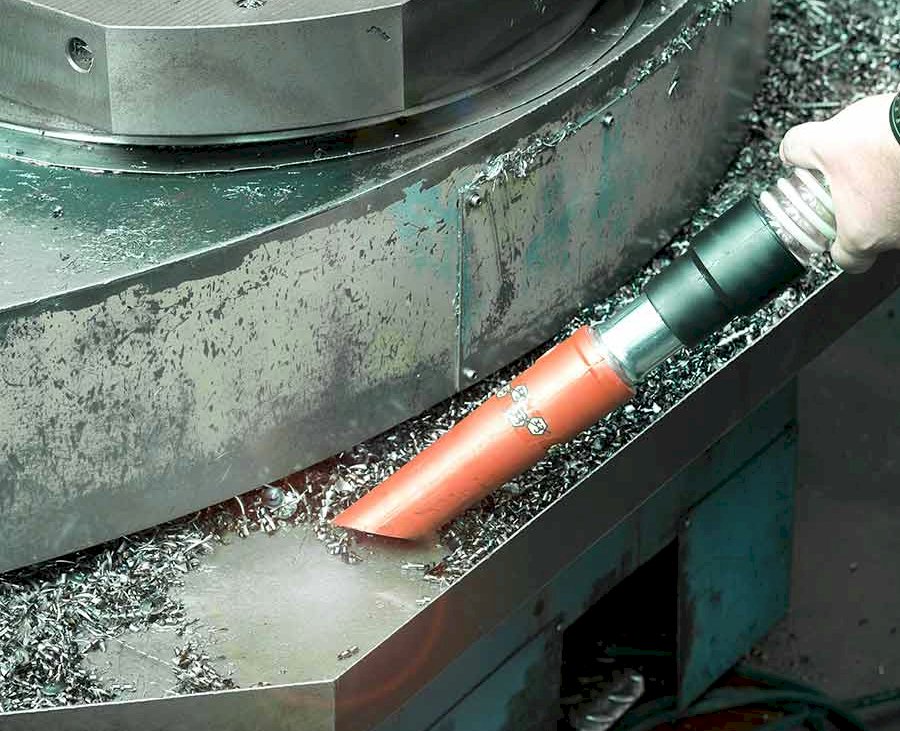Metalworking Vacuum Cleaners: One Type Does Not Fit All
As the metalworking industry becomes more specialized, so does the equipment that cleans it. But as diverse as the industry is, it should come as no surprise that there is no single vacuum that can handle all of its requirements. Even after separating applications into wet and dry, no single vacuum can handle all requirements of either category. Either for fluid management, protecting equipment from carbon fiber dust, or in finishing operations, employing the right metalworking vacuum can increase uptime, preserve product quality, enhance plant safety, and extend the lifespan of expensive equipment and materials.
General-purpose vacuums such as the shop-type wet/dry vacuums found on the shelves at hardware stores are not uncommon in metalworking facilities. But they really are not sufficient for such applications. Those vacuums tend to be used in more of a janitorial sense for picking up small puddles or small debris. The inadequacy becomes clear when attempting to clean out a sump with 50 gallons of oil. This job could be done in less than a minute with an industrial vacuum, but will take four times as long with a shop-type vacuum, and it will die in short order because it cannot withstand such tasks on a day-to-day basis.
When looking to clean a machining center or other machine tool or waterjet cutter, more specialized solutions should be considered that can handle everyday use. Often users know they want something “industrial,” but they don’t know what that is. To better understand how the diversity of metalworking applications relates to vacuum cleaning solutions, it is beneficial to examine some of the most common vacuum types used in the metals industry to handle regularly encountered debris.
Continuous Duty for Metalworking
Continuous duty vacuum cleaners are designed to withstand 24/7 operation and to handle some of the toughest materials, including heavy steel shot or mounds of fine powders. Powerful enough to pick up a bowling ball, portable continuous duty vacuums are available with motors ranging from 5 hp to 30 hp and with add-on intercept vessels to expand collection capacity and improve material handling.
Combustible Dust Vacuums
Combustible dust vacuums are completely grounded and bonded to meet the NFPA 70 requirements for grounding and bonding. These vacuums also meet the definition of an “intrinsically-safe system.” Although some combustible dust vacuums are available with electric motors, air-powered vacuums do not use electricity and do not generate any heat from operation. Combustible dust in a metalworking environment include powder coatings, aluminum and magnesium dust.
Stationary Vacuums
Stationary vacuum cleaning systems eliminate the need for chip carts and manual emptying, allowing operators to clean workpiece holders, parts carriers and T-slots quickly. One common stationary system consists of a vacuum pump and specialized receiver to collect chips and discharge them into a floor-level or below-grade chip conveyor for disposal, totally eliminating the need to empty a collection drum or hopper. This design enables operators to focus on making more parts. Another type of stationary vacuum system automatically collects chips from individual machine tools that are equipped with drag or screw conveyors and delivers the chips to a central location. Chip carts and manual emptying are eliminated.
Metalworking Liquid Recovery Vacuums
Sometimes called “pump-in, pump-out vacuums,” metalworking liquid recovery vacuums pick up liquids at 1 to 2 gallons per second. In addition to the ability to pick up 100 percent liquids, these vacuums also recover liquids with solid particles, such as chips and are equipped with a lever that converts the unit from vacuum mode to pump-out mode to discharge filtered liquids from the drum at a controlled rate.
Check out some options here with the 303PL & 423PL, or the Niulfisk S3 here.
Industrial Wet/Dry Vacuum
Intended more for one-way vacuuming of metalworking liquids and debris, wet and dry, these multi-purpose vacuums out-perform vacuums found at home improvement stores and janitorial catalogs.
Tank Kit Vacuums
Tank kit vacuums, which can be used with closed-top drums, are air-powered liquid recovery vacuums designed to handle materials that are more viscous. Placement of the vacuum mechanism outside the drum allows the drum to fill to 99 percent of its volume. Tank kits are well suited to clean out parts washers.
The range of industrial vacuums available for specific metalworking applications and debris, coupled with tools and accessories tailored to application needs, has advanced the equipment beyond general housekeeping and safety uses and into production tools that increase uptime and improve product quality. Following is a list of common debris encountered in the metalworking industry and industrial vacuums types suited for tackling them.
Metalworking Coolants
For vacuuming coolants and chips away from a machining center, specialized liquid recovery vacuums, equipped with chip baskets and liners, preserve the integrity of the coolant and permit recovered fluids to be pumped back into the system. These vacuums reduce the accumulation of chips and fines in the sump and keep workers safer by cutting down on bacterial and fungal growth. These systems are also ideal for larger metalworking jobs, such as high-speed milling of aircraft wings, where fluid must be removed from cavities in order to take precision measurements.
Sludge and Swarf
Removal of sludge from sump pits and waterjet cutting tables is another common application for vacuums in the metalworking industry. This sand-like semi-solid material forms when residual particulates and chips settle in the bottom of a sump. This sludge is an ideal breeding ground for harmful bacteria and fungus that endangers workers’ health, shortens the life of metalworking fluids, interferes with machine function and can eventually plug fluid lines. According to tool manufacturers, dirty machine coolant can reduce tool life by as much as 10 percent.
Some shops still clean sump pits manually. Because this is a nasty job, sometimes pits don’t get cleaned as often as they should, causing unnecessary wear on machinery and extended periods of downtime during sludge removal. Using a continuous duty vacuum that facilitates high volume recovery of as much as 5 tons per hour can not only reduce the downtime necessary to remove sludge, but can also protect workers from ergonomic issues associated with shoveling masses of sludge.
Metallic filings or shavings removed by cutting or grinding tools should be cleaned with an industrial wet/dry vacuum. In addition, vacuums are used to suck swarf from trays and dump it into briquetting machines.
Metalworking Chips
In wet cutting, chip baskets in liquid recovery vacuums capture and separate chips from metalworking fluids. In dry cutting, dry vacuums are used to remove debris from machining centers. Abrasion-resistant hoses are important when vacuuming chips.
Turnings
Turnings—the longer byproducts of lathes—can clog vacuum hoses and therefore are not a good candidate for industrial vacuuming.
Punch Outs
Waste metal formed by punching holes in sheets can be collected with dry vacuums and nozzles or with high volume continuous duty vacuum systems that continuously suck the punches from trays or pickup points and dump them into collection containers.
Mill Scale
The flaky surface of hot-rolled steel, when scattered about, is effortlessly picked up with a dry vacuum. But when in piles, a heavy-duty continuous duty vacuum is better equipped for the job.
Slag
These granular or irregular-shaped abrasive chunks, a byproduct of submerged arc welding, generally need a heavy-duty continuous-duty solution. It is fairly common to automate the process of removing slag with a vacuum cleaner.
Flux
This fine powder is a source for fugitive dust that comes from large-scale automated welding. It needs a dry vacuum for fine powders. With specialized vacuum accessories, flux powder can be recovered and reused.

Metalworking Grindings
The debris from manually grinding metals is difficult to capture and becomes a fugitive dust problem. Depending on the material, dry vacuums are sufficient to clean up grindings at the end of the shift. However, as materials dictate, a combustible dust vacuum may be necessary to remove grindings immediately.
Shot-Blast Media
Shot peening and abrasive blasting can create slip hazards and ergonomic issues. If machines leak or the media lodges in parts and falls out in the plant, it is like walking on ice. Because the material is heavy, manual cleaning methods carry the risk of a back injury. Continuous duty, heavy-duty vacuums, capable of generating 12-inch Hg, are necessary for cleaning this media. Vac-U-Max produces a vacuum cleaning solution to suck the media into a collection vessel and then deposit it back in the blast machine for reuse, without operator handling.
Abrasive Media (Dry)
Non-destructive abrasive media such as corn starch, walnut shell products and plastic grit are combustible dust hazards and require vacuums designed for use in Class 2 Div II areas. The dust may also contain hazardous materials such as cadmium or silica, requiring the use of a Hepa-filtered vacuum.
Abrasive Media (Wet)
Abrasive flow machining (AFM) media has viscoelastic or rubber-like properties. A heavy-duty vacuum eliminates the need to shovel the media, and collects it for reuse.
Carbon Fiber
Dust created from machining carbon fiber is fine, slippery and conductive. It can be harmful to electronics and can create slippery conditions, thus requiring frequent vacuuming. The best vacuum for cleaning carbon fiber dust would be a grounded and bonded, air-powered vacuum with high efficiency, static-conductive filter and provision to collect the debris in a polybag liner.
There is no single industrial vacuum that can handle all of the requirements of the metalworking industry, but appropriate vacuum cleaning solutions are available for almost every application. Consulting with an industrial vacuum specialist about a shop’s needs will lead to ideal solutions to increase uptime, create a healthier workplace and preserve expensive equipment and materials.
Metalworking Vacuums
Do you need a metalworking vacuum for your business? Talk to the South Pacific Vacuums team today, call +64 9 520 20 30 or +64 4 234 1020, or use our contact form here to send a message with your specific needs.
Like most businesses we’re social – you can follow us on Facebook, Instagram, LinkedIn, Twitter.
Follow us and we’ll follow you, now that’s social.


